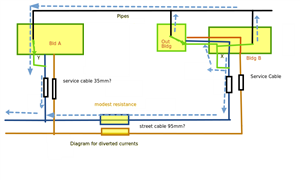Proposed scenario: 200A 3ph DNO supply to a 15 yr old building, upgraded from the present 100A. From this building a couple of Distrib ccts, one to a small commercial kitchen / dining room / sports hall / laundry room all in one separate building (they were farm buildings many years ago), another to a further separate building now a modest sized meeting room, with electric showers included within the toilet facility.
DNO supply is as far as can be ascertained, TN-C-S. Local transformer serving a number of local properties is on a pole about 120m away from "our" pole, from which drops a cable to run underground a few metres to the 'new' building.
Existing supply to the two outbuildings described above is from a separate 100A 3ph DNO feed from the same pole, the service head being in an old barn, thence distrib ccts in SWA. The Earth from this supply is exported to these two buildings via the armour. There's also a small earthing conductor to a local earth rod beside this old barn. It's' proposed to utilise this 100A supply for a new development elsewhere on the site.
Question: normally we're not permitted to export the earth from TN-C-S in one building to another, but make the remote building TT. This is fine - except that it's quite possible (but impossible to check) that the water mains to each of the 3 buildings concerned might be in iron pipes. Thus as soon as the water bond is connected in each building, their main earth terminals would be effectively linked by the mains water pipes, therefore exporting the TN-C-S earth by a different route. Is this an issue and what could be a solution? OK, I'm over-thinking again, but the question must be asked.

